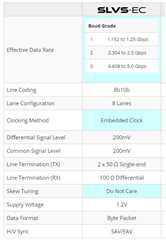I am considering an SLVS-EC signal extension circuit using TLK10002 and SFP+.
The electrical signal of SFP+ (10Gbps) is CML and NRZ.
The input level of TLK10002 can receive SLVS-EC (5Gbps) signals.
I don't think there will be any electrical problems if you use these.
Please let me know if there are any problems with the protocol.


